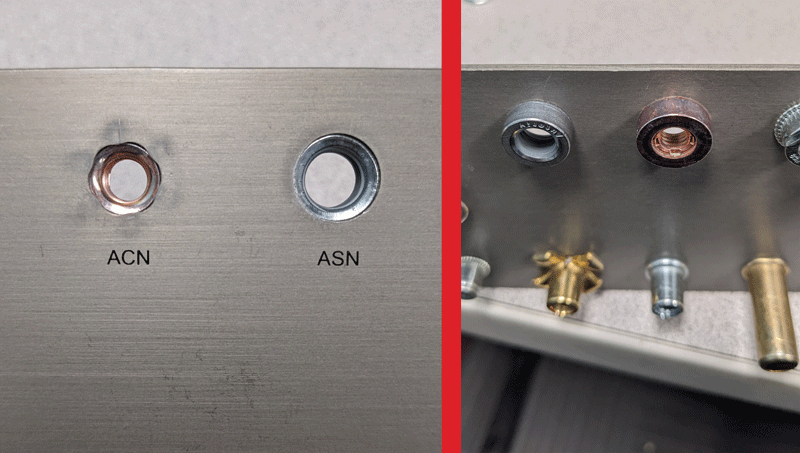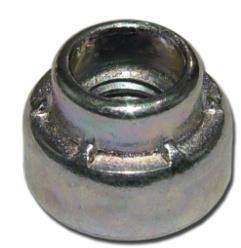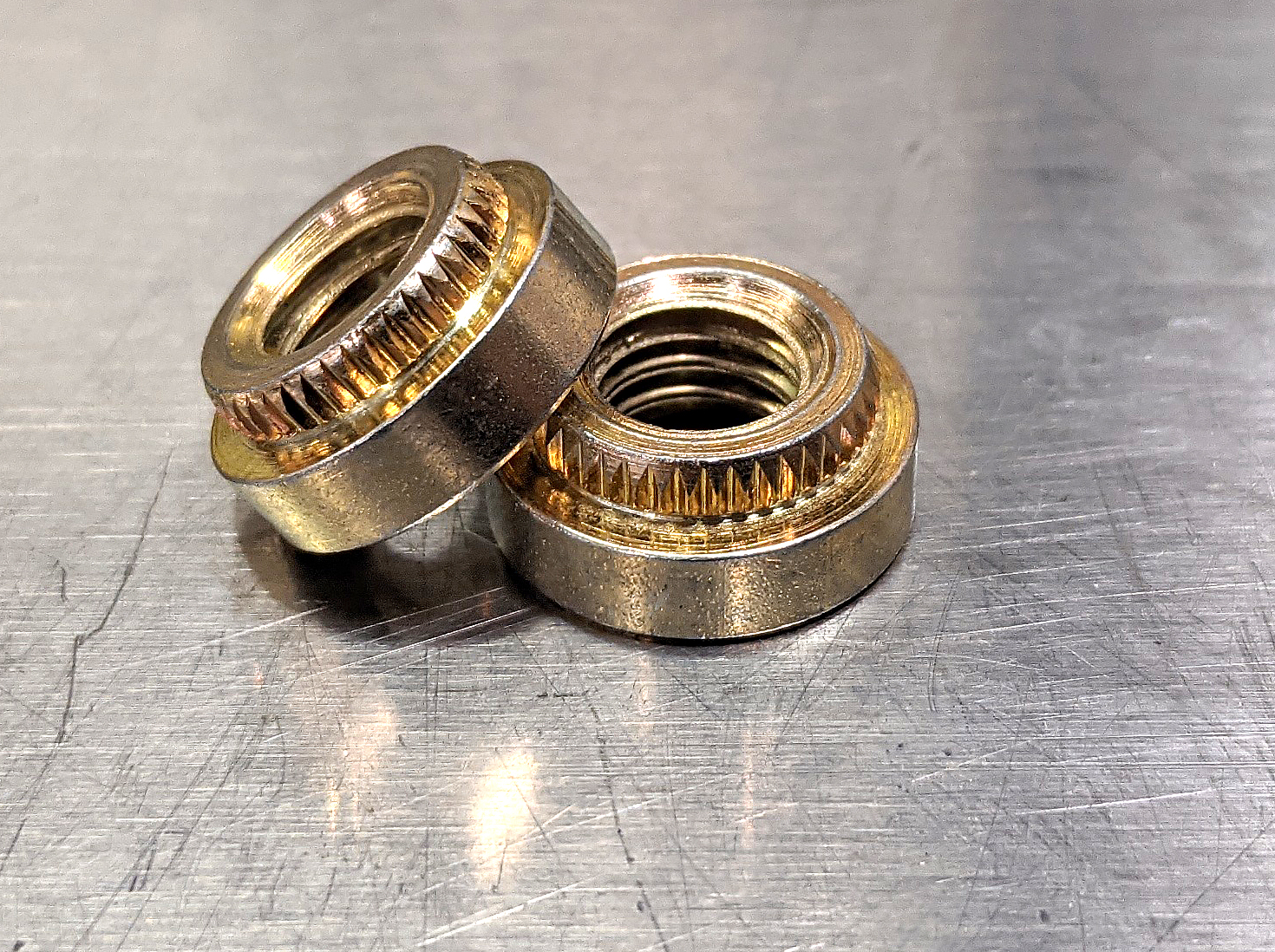Different Styles of Clinch Nuts
Leave a CommentA major benefit of rivet nuts are the variety of styles. Well not to be outdone, clinch nuts also come in a few standard styles that each have its own benefits.
Let’s take a look at different styles of clinch nuts:
ACN Series – High Strength Clinch Nut

ACN Clinch Nut
On this clinch nut, there are displacement lobes that force the sheet metal to flow into the locking groove when pressed in. This allows sheet metal to remain flat with no indentation and providing the nut with high push out and torque values. The base material remains flush.
This style of clinch nut is designed for thicker sheet metal applications from 2mm to 10mm thick, and is compatible with Class 8, 9, & 10 hardware depending on application requirements.

Front and backside of installed ACN and ASN Clinch Nuts. Notice the flush installation on the front side.
PHOTO: How Clinch Nuts are Installed>>
VIDEO: Installing a Clinch Nut with a FLEX-18>>
ASN Series — Serrated Style Clinching Nut Series

ASN Clinch Nut
This clinch nut has extensive knurls that push into the material. During installation, sheet metal is formed into an undercut section on the nut collar by the die button and the knurled ring. As a result, the nut has high push out and torque values, and space requirement is minimal due to the small outer diameter and flat installation surface.
The ASN clinch nut can be used in sheet metal applications from 1.5mm to 10mm thick, and is compatible with Class 8, 9, & 10 hardware depending on application requirements.
ARN Series – Universal Clinch Nut

ARN Clinch Nut
The ARN Series clinch nut is a unique style of clinch nut that has locking grooves to dig into the material when pressed in, while the neck part of the clinch nut is crimped over the base material using a special die, making the base material “almost flush.” Locking grooves are the clinch feature of the nut, providing high push out, pull through, and torque values, even in very thin sheet materials. The nut can be installed using several different installation methods depending on the sheet material thickness, hardness, and installation clearance.
Can be used in sheet metal from 0.4mm to 6mm thick, and is compatible with Class 8, 9, & 10 hardware depending on application requirements.
Custom Clinch Nuts
 Some projects that require clinch nuts might need a higher tolerance grip range, or something that can bite into the material more, or a different coating. Sherex can design-in and manufacture special clinch nuts for your project. Be sure to look at our post Rivet Nuts vs Clinch Nuts to read the differences and similarities between the two fasteners!
Some projects that require clinch nuts might need a higher tolerance grip range, or something that can bite into the material more, or a different coating. Sherex can design-in and manufacture special clinch nuts for your project. Be sure to look at our post Rivet Nuts vs Clinch Nuts to read the differences and similarities between the two fasteners!
If considering a clinch nut for your project and want to discuss what the best clinch nut for your project will be, contact us!
To use Rivet Nuts or Clinch Nuts?
Leave a CommentBy Tyler Jones
Sherex Application Engineer
When material is too thin to tap threads, clinch nuts and rivet nuts are used to help fasten the application. Both rivet nuts and clinch nuts allow for additional components to be attached using these threaded fasteners, and both attach mechanically to the base material. But what’s the difference? Which one is better?
Using a Clinch Nut over a Rivet Nut

Clinch nuts are great. They are smaller, self-clinching, internally threaded nuts that are pressed into the base material. Some of the advantages of using a clinch nut over a rivet nut are:
- Can be installed in very thick base material.
- There can be almost flush installation on the base material with clinch nut installation. Some small flange rivet nuts or countersunk rivet nuts can make near flush installation, but not as flush as clinch nuts.
- There isn’t a specific installation tool for clinch nuts. They can be installed with something like an arbor press, though automation systems are very popular for clinch nut installation.
- Can fit different material geometries than rivet nuts.
Using Rivet Nuts over Clinch Nuts

Rivet nuts are also great. Often referred to blind rivet nuts, they are threaded inserts that install on one side of the application to provide a strong attachment point. Unlike clinch nuts, these are installed by pulling the base of the rivet nut and crimping it to one side of the material, instead of being pressed on. Installation requires specific rivet nut tooling to crimp the rivet nut on to the material. Advantages of rivet nuts of clinch nuts are, generally:
- Rivet nuts have a wide variety of shapes, sizes, and can even feature floating threads.
- Very easy to install with proper tooling.
- Stronger thread. Rivet nuts, generally, and especially with hexagonal body, are more resistance to spin-out than clinch nuts.
- Cost of standard rivet nuts is similar to the cost of a standard clinch nut.
Comparing and Contrasting Installation of Clinch Nuts and Rivet Nuts
When installing Clinch Nuts, access to both sides of the base material is needed. For Rivet Nuts, installation is only needed with having access to one side of the base material or work piece.
As far as tooling is concerned, Rivet nuts and clinch nuts have the ability to be installed using a Spin-Pull Rivet Nut Tools, but for the most part, clinch nuts need to be pressed into the material.
For high volume installations, fastener automation systems are the preferred method to install both clinch nuts and rivet nuts, but some rivet nut hand tools can be used for high volume installation of rivet nuts, including for use on an assembly line. For a manual approach to installing clinch nuts, something as simple as an arbor press can provide installation.
With price between clinch nuts and some standard rivet nuts as fairly similar, factors into determining when to use a clinch nut can be:
- Is there access to install using the backside of the work piece?
- How much thread strength and spin out is required for the application?
- Will installations be performed by an operator or through automation?
The answer to these questions will help determine if a clinch nut or rivet nut will make the best fastener for your application. For suggestions on the best fastener to use for your project, please contact Sherex Fastening Solutions.





